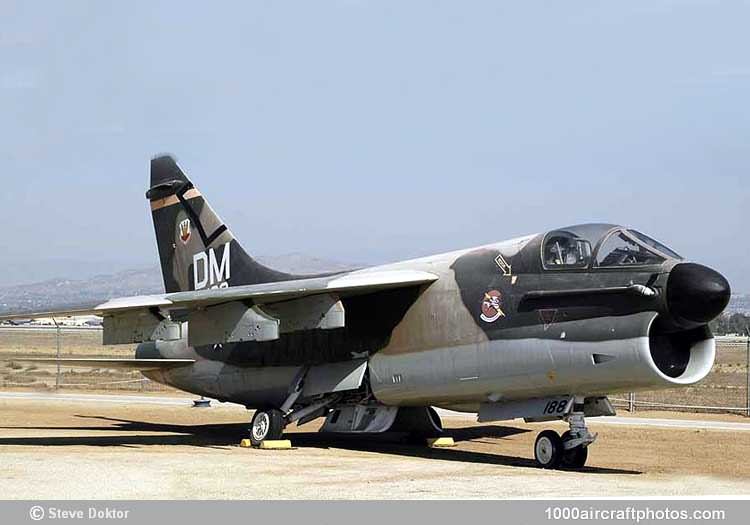06/30/2014. Remarks by Johan Visschedijk: "A USAF decision in 1966 to order a version of the Ling-Temco-Vought Corsair II marked the second occasion within a decade when a Navy-inspired combat aircraft was adopted by the Air Force virtually off-the-shelf. (The precedent had been set by the McDonnell F-4 Phantom II).
The Corsair II had been designed in 1963 to meet the USN's VAX requirement for a relatively cheap, subsonic attack aircraft which, under the terms of the specification, had to be based on an existing design. The winning design, from Ling-Temco-Vought's Aerospace Division was based on the F-8 Crusader and was selected for production in February 1964.
An attempt by the Department of Defense to have the USAF combine with the USN and USMC to write a common VAX specification failed, but following successful testing of the prototype Navy A-7As (starting on September 27, 1965), USAF interest in the design grew steadily and a formal request to buy A-7s was included in the FY 1967 Air Force budget.
To meet USAF requirements, the Corsair was modified in several respects, the most significant being the use of a version of the Rolls-Royce Spey turbofan in place of the Pratt & Whitney TF30 used by the Navy. The Spey engine was developed jointly with Allison as the 14,500 lb (6,577 kg) st TF41-A-1 turbofan for the USAF's A-7D, and offered an increase of 2,000 lb (907 kg) thrust over that of the TF30. Other changes, several of which were later adopted by the USN in its A-7E version, included installation of a 0.787 in (20 mm) multi-barrel cannon, and a new, advanced nav/attack system including a digital computer, head-up display, projected map display and laser rangefinder.
To start flight development of the A-7D systems, two prototypes were completed with TF30-P-6 turbofans, and the first of these flew on April 5, 1968. The first aircraft to fly with the TF41 Spey took to the air on September 26, 1968. Provision for boom flight refueling, in place of the Navy's probe/drogue system, was introduced on the 17th production aircraft, with a receptacle in the top of the fuselage behind the cockpit.
Deliveries of A-7Ds for USAF testing began on December 23, 1968, followed by the first of the definitive production variant in July 1970. A total of 459 A-7Ds were built, equipping three Tactical Air Command wings and two Air National Guard squadrons. During the early 1980s, most A-7Ds were replaced by A-10 Thunderbolt IIs in USAF front-line service, but it remained in the Air National Guard squadrons for a while longer, equipping an eventual total of 14 ANG squadrons.
The pictured aircraft was delivered to the USAF on June 1, 1970 and assigned to the 58th Tactical Fighter Wing (TAC) at Luke AFB, Arizona. On June 1, 1971, it was transferred to the 355th Tactical Fighter Wing (TAC) at Davis-Monthan AFB, while in January 1977 it was transferred to the Lowry Technical Training Center (ATC) at Lowry AFB, Colorado, where, after 1,777 flying hours, it was converted to a GA-7D (ground instructional vehicle). Subsequently it was put on display at the Wings Over The Rockies Aviation and Space Museum at Denver, Colorado. On May 14, 2002, the aircraft was trucked to March Field Air Museum at Riverside, California, where it since is on display on loan from the Air Force Museum, Wright Patterson AFB, Ohio."
